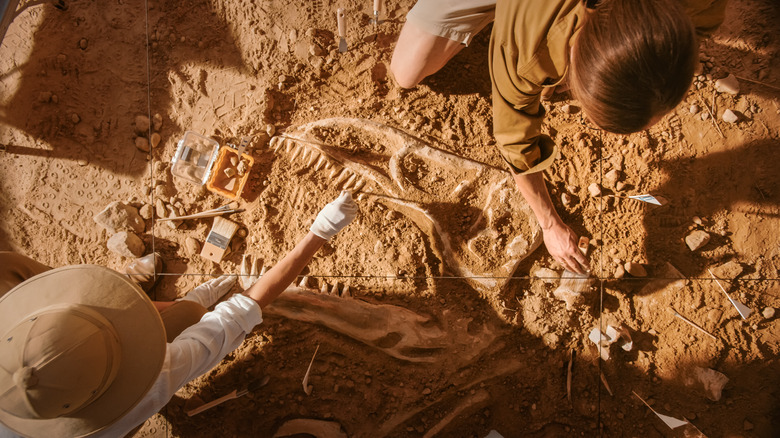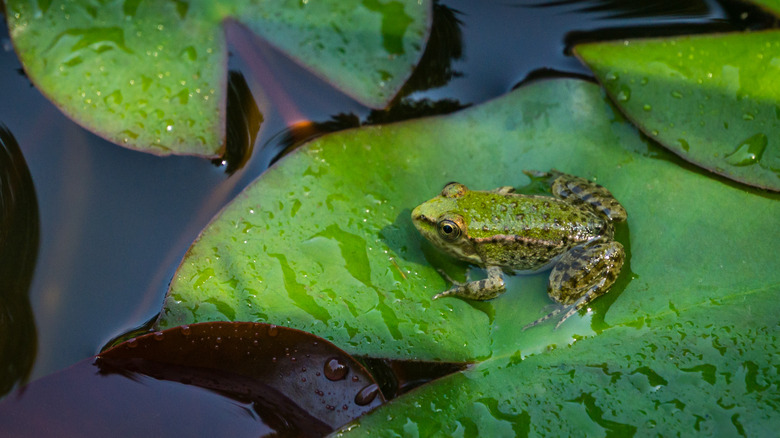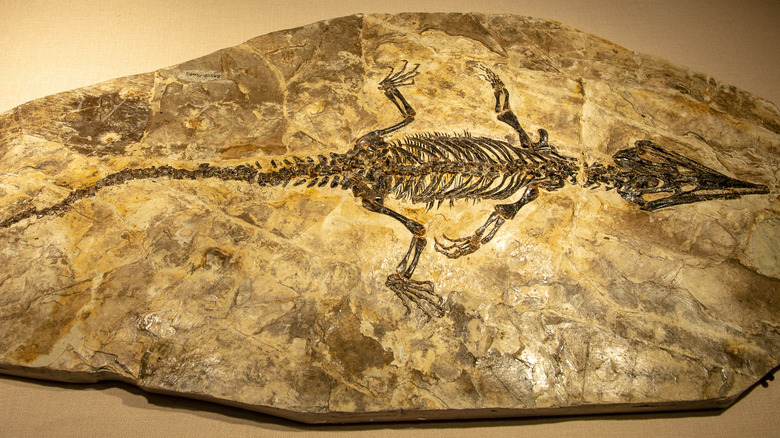What A Dinosaur's Fossilized Intestines Reveal About Other Dinosaurs
Scientists discovered a new dinosaur species called Daurlong wangi in China in 2022, reports a study titled "Intestinal preservation in a birdlike dinosaur supports conservatism in digestive canal evolution among theropods” (via Nature). Science News explains that the Daurlong Wangi belongs to the dromaeosaurid family. According to The University of California Museum of Paleontology, dromaeosaurs are more commonly known as raptors. The institution notes that they share an ancestor with birds. Dromaeosaurs were compact creatures, however, Live Science reports that at less than five feet long, Daurlong wangi was even smaller. In addition, it's believed that they lived in Inner Mongolia during the upper Cretaceous period between 130 and 120 million years ago.
Per Live Science, "Daurlong" is a nod to the Daur people native to Inner Mongolia. "Long" is the Chinese word for "dragon," while "Wangi" is for Wang Junyou, the director of the Inner Mongolian Museum of Natural History. The Science Times notes that Daurlong wangi's unearthing is revolutionary for several reasons. Besides the revelation of a new species, the preservation of the fossil allowed scientists to inspect its intestines. This is extraordinarily rare, and as Andrea Cau, a co-author of the study, put it (via Live Science), "This is the first case among dromaeosaurids."
Dromaeosaurs' intestines didn't evolve until after the Cretaceous period
When paleontologists discovered the Daurlong wangi, the study released in the scientific journal, Nature, states that they were taken aback by the preservation of its intestines. The study describes the fossil as having a blue-colored abdomen that researchers concluded were, in fact, its guts. Inside was a frog skeleton, according to Science News. Moreover, this is the first instance of the intestinal preservation of a theropod with bird ancestry. Dromaeosaurs, notes The University of California, Museum of Paleontology, are theropods. Live Science explains that this breakthrough allows researchers to learn more about the digestive system and diet of dromaeosaurs.
Furthermore, it provides insight into the lives and nutrition of the newly unearthed Daurlong wangi (per The Science Times). Live Science reports that the Daurlong wangi's intestines appear similar to other carnivorous dinosaurs. Their diet likely consisted of fish and small dinosaurs. Andrea Cau added (via Live Science), "Given the abundance of frogs and other amphibians in the Daurlong locality," they may have also eaten salamanders. This also demonstrates that the intestines of dromaeosaurs likely only evolved after the Cretaceous period. Dromaeosaurs were carnivores, but there's been speculation that some became omnivores (via Smithsonian Magazine).
The Daurlong wangi's stomach was not preserved
Per Live Science, it's believed that the Daurlong wangi became preserved after it fell into a lake 100 million years ago. The study (via Nature) notes that the process did not preserve the creature's stomach. This was likely due to the environment being too acidic. However, the Daurlong wangi's remains and intestines did not disintegrate because they were buried underwater with soft sediment and little oxygen or bacteria. As a result, the Daurlong wangi became fossilized. Despite the lack of a stomach, Andrea Cau said he has big plans for the Daurlong Wangi.
He told Live Science, "Our hope is to determine some information about its plumage color in life and to better reconstruct the peculiar conditions which led to soft tissue preservation." Having said that, Science News reports that researchers concluded that the Daurlong wangi lived during the Jehol Biota. According to a study (via ScienceDirect) titled "The Jehol Biota: Definition and distribution of exceptionally preserved relicts of a continental Early Cretaceous ecosystem," the Jehol Biota describes the Lower Cretaceous period in northeastern China. Several significant fossils, like the Daurlong wangi and the one pictured above, have emerged from this epoch.


